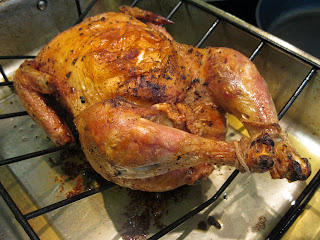I can't stress enough that the quality of the chicken used for this recipe is critical to its overall success. If you use a factory-farmed poultry for this, or for any chicken recipe, you'll probably have to add a fair amount of enhancement and preparation time and effort to get anything close to as good as this will yield just with the very simple elements of chicken, lemon and seasonings. The extra cost for an organic chicken will more than pay for itself in quality of taste, nutrition and, as recent reports are indicating, healthiness.
This is the roasting pan I use from Sur La Table.
17" x 12 1/2" x 3"
A less expensive generic roasting pan would work well also.
17" x 11" x 2"
I use a roasting rack to put the chicken on - this allows for the bird to sit above the drippings.
Indispensable tools for any chef - a well sharpened chef's knife, a quickie sharpener and a honing steel.
A whole organic free-range chicken washed inside and out.
The seasoned chicken with fork-pierced lemons for the cavity.
The bird on the rack prior to cooking - here the back side is facing up.
The finished chicken showing the leg tie. The breast-side is facing up.
17" x 12 1/2" x 3"
A less expensive generic roasting pan would work well also.
17" x 11" x 2"
I use a roasting rack to put the chicken on - this allows for the bird to sit above the drippings.
Indispensable tools for any chef - a well sharpened chef's knife, a quickie sharpener and a honing steel.
A whole organic free-range chicken washed inside and out.
The seasoned chicken with fork-pierced lemons for the cavity.
The bird on the rack prior to cooking - here the back side is facing up.
The finished chicken showing the leg tie. The breast-side is facing up.
Tools:
roasting pan
roasting rack
a very sharp good chef's knife (*see my post about knives)
a cutting board on which you can carve the cooked chicken
an instant-read food thermometer (*cheap and well worth the cost)
butcher twine
one 3-4 pound whole free-range organic chicken
2 small lemons
fresh-cracked black pepper
Kosher salt
Directions:
Preheat the oven to 350F.
Wash and dry the chicken thoroughly and remove any loose fat from the inside. (Be sure to clean your hands and any implements thoroughly that have come into contact with the uncooked chicken to avoid any potential salmonella issues.) Combine fresh cracked pepper and salt into about a 1/4 cup overall and with your hand spread liberally inside the chicken and outside on the skin. Perforate the lemons several times with the tines of a fork and put into the chicken cavity. Use 2 or 3 sturdy toothpicks to close up the cavity so that the lemons do not tumble out. To close, pierce each toothpick on one cavity flap and pull through to the opposite flap. Then tie the ends of the legs together with butcher twine.
Place the chicken back-side up on a rack in a roasting pan then put into the preheated oven to cook for 30 minutes. Remove the pan from the oven to flip the chicken to breast-side up for the remaining cooking time increasing the heat up to 400F. Cook until your food thermometer registers that the internal temperature is about 175F. The best way to determine this in a whole chicken is to put the thermometer into the thigh making sure not to have it touch any bones. For a whole chicken I find it takes about 18-20 min a pound to cook to the desired temperature.
Remove the roast from the oven, place onto a cutting board or platter and cover with foil and allow to rest for about 15 minutes. The rest is critical to cooking any kind of meat as once removed from the heat source, the tasty juices in the meat require time to recede back into it. If you don't let it rest, the meat will inevitably lose those juices, hence moisture, and much of the meat's flavor,
Optional step:
If you want to try it, you can use the pan's remaining juices from the roast to make a quick gravy if you like. I generally put the pan over two burners, adding some white wine, bringing it up to a boil and then using a wooden spoon to scrape the hardened drippings to incorporate into a sauce that I allow to cook to reduce to the consistency I like. Reduction is a technique of heating a liquid to the extent that much of the water content evaporates leaving the remainder which usually holds concentrated flavor - this is what they mean in a restaurant when they refer to a gravy or sauce as a 'reduction'.
If you have time to allow it to cool a little, spoon off any floating fat before using.
I've used this recipe in classes as an easy-to-prepare no-fail chicken dinner and people are amazed how good a meal this simple recipe will produce. Again the secret is getting a really good chicken to start with!







